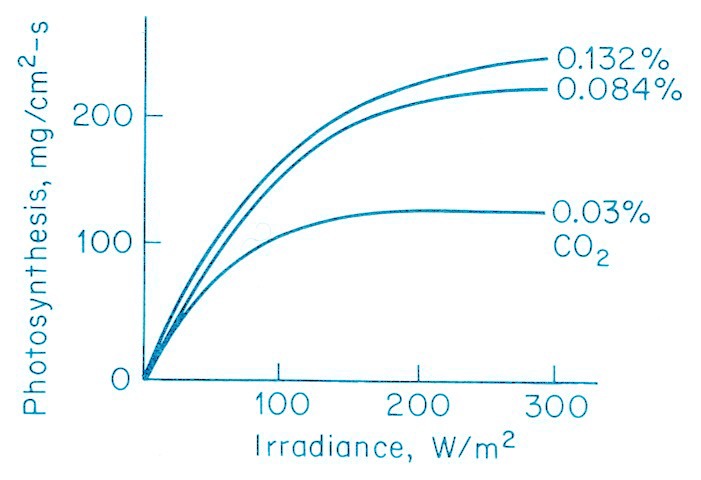3.2.32 Bioplanet -
Pflanzenwachtstum, Sauerstoffproduktion
Ernährung, Grüne Erde
en
Bioplanet -
Plant growth, Oxygen production, Nutrition, Green Earth
fr
Bioplanète -
Croissance végétale, nutrition, production d'oxygène, Terre verte
Mit folgenden Links wird von anderen Webseiten auf diese Seite verwiesen:
| de | en | fr |
|---|---|---|
|
Klima: Fragen Bioplanet Pflanzenwachtstum, Sauerstoffproduktion, Ernährung, Grüne Erde |
Climate: Questions Bioplanet Plant growth, Oxygen production, Nutrition, Green Earth |
Climat: Questions Bioplanète Croissance végétale, Nutrition, Production d'oxygène, Terre verte |
|
⇑
Inhalt |
|
de Auswirkungen der CO2-Konzentration auf das Pflanzenwachstum Pflanzen benötigen zur Photosynthese Kohlenstoffdioxid (CO₂) und produzieren dabei Sauerstoff.
Wird den Pflanzen zusätzliches Kohlenstoffdioxid zur Verfügung gestellt, Falls der Verbrauch fossiler Treibstoffe nicht närrischerweise limitiert wird im Zuge eines abwegigen Versuches, den Klimawandel zu verhindern - zuvor globale Erwärmung genannt - wird die erwartete Zunahme der CO2-Emissionen in der Atmosphäre die Ernteerträge sowie die Wasser-Effizienz aller in der Welt erzeugten Nahrungsmittel deutlich verbessern. Dies erlaubt es uns die wachsende Weltbevölkerung weiter zu ernähren auch noch weit über das Jahr 2050 hinaus. Dann werden Berechnungen zufolge etwa 9 Milliarden Menschen auf der Erde leben, verglichen mit den heutigen 7,2 Milliarden. en NASA Study Shows: Human Activity in China and India Dominates the Greening of Earth Data from NASA satellites shows that China and India are leading the increase in greening on land. Taken all together, the greening of the planet over the last two decades represents an increase in leaf area on plants and trees equivalent to the area covered by all the Amazon rainforests. |
de Allgemein en General fr Générale
| de | en | fr |
|---|---|---|
|
Auswirkungen des Klimawandels Bioplanet Pflanzenwachtstum, Sauerstoffproduktion, Ernährung, Grüne Erde |
Impacts of Climate Change Bioplanet Plant growth, Oxygen production, Nutrition, Green Earth |
Conséquences du changement climatique Bioplanet Croissance végétale, Nutrition, Production d'oxygène, Terre verte |
CO2 = Pflanzendünger
en
CO2 = Plant Food
fr
CO2 = Engrais pour les plantes
|
|
de
CO₂ = Pflanzendünger en CO₂ = Plant Food fr CO₂ = Engrais pour les plantes |
|||
| ▷Die Kalte Sonne Blog‑Themen Vahrenholt/Lüning ▶Die kalte Sonne |
de
▷CO2 und andere Treibhausgase
▷CO2-Düngung |
|||
| ►Der Wasserplanet (Ernst-Georg Beck) | de ▷Biologische Eigenschaften von CO₂ (Wayback‑Archiv) | |||
|
Wikipedia |
|
|||
| Vademecum |
▶CO₂ = Pflanzendünger
▶Welt-Info |
| de | en | fr |
|---|---|---|
|
Auswirkungen des Klimawandels Bioplanet Pflanzenwachtstum, Sauerstoffproduktion, Ernährung, Grüne Erde |
Impacts of Climate Change Bioplanet Plant growth, Oxygen production, Nutrition, Green Earth |
Conséquences du changement climatique Bioplanet Croissance végétale, Nutrition, Production d'oxygène, Terre verte |
Auswirkungen der CO2-Konzentration auf
das Pflanzenwachstum
en
Impact of the CO2-Concentration
on the plant growth
fr
Impacte de la concentration du CO2
sur la croissance des plantes
2010-04-09 en
![]() Seeing is Believing
Seeing is Believing
Isolated for 42 days in chambers of ambient and elevated CO2 concentrations, we periodically document the growth of cowpea plants (Vigna unguiculata) via time-lapse photography.
2013-03-13 en
![]() Matt Ridley on How Fossil Fuels are Greening the Planet
Matt Ridley on How Fossil Fuels are Greening the Planet
Over the past three decades, our planet has gotten greener!
Even stranger, the greening of the planet in recent decades appears to be happening because of, not despite, our reliance on fossil fuels.
While environmentalists often talk about how bad stuff like CO2 causes bad things to happen like global warming, it turns out that the plants aren't complaining.
-
Barrett Bellamy Climate
en The giver of lifeThis is a short description of the process of photosynthesis and how the carbon dioxide molecule gives us life as well as heat

 The giver of life
The giver of life
This is a short description of the process of photosynthesis and how the carbon dioxide molecule gives us life as well as heat

The graphs show how the rate of photosynthesis varies with irradiance, the three experiments differing only in the concentration of CO2.
The lowest graph is that for a CO2 concentration of 0.03%, much as it is at this time [actually ~385 ppmv or 0.0385%].
In the early part of the graph the rate of the reaction is related almost directly to the amount of irradiance, but the rate falls off at higher irradiances and eventually levels off.
This tells us that at higher irradiances it is the concentration of CO2 that limits the reaction rate, there is sufficient light falling on the leaves, but the requirement for more CO2 is the limiting factor.
We strongly object to CO2 being regarded as a pollutant; it is the giver of life and we all depend upon its chemical and radiative properties.
| de | en | fr |
|---|---|---|
|
Auswirkungen des Klimawandels: Bioplanet CO2 = Pflanzendünger |
Impacts of Climate Change: Bioplanet CO2 = Plant Food |
Conséquences du changement climatique: Bioplanet CO2 = Engrais pour les plantes |
Die Erde wird grüner
en Earth greening
fr La terre devient vert
| de | en | fr |
|---|---|---|
|
Auswirkungen des Klimawandels: Bioplanet Die Erde wird grüner |
Impacts of Climate Change: Bioplanet The Earth is greening |
Conséquences du changement climatique: Bioplanet La terre devient verte |
en ASA Study Shows: Human Activity in China and India Dominates the Greening of Earth
![]()
![]() Over the last two decades, the Earth has seen an increase in
foliage around the planet,
Over the last two decades, the Earth has seen an increase in
foliage around the planet,
measured in average leaf area per year
on plants and trees.
Data from NASA satellites shows that China and India are leading
the increase in greening on land.
The effect stems mainly from ambitious tree planting programs in
China and intensive agriculture in both countries.

-
Watts UP With That? (Anthony Watts) / Charles Rotter
2020-02-14 en Human Activity in China and India Dominates the Greening of Earth, NASA Study ShowsThe world is literally a greener place than it was 20 years ago, and data from NASA satellites has revealed a counterintuitive source for much of this new foliage: China and India.
A new study shows that the two emerging countries with the world's biggest populations are leading the increase in greening on land.
The effect stems mainly from ambitious tree planting programs in China and intensive agriculture in both countries.
The greening phenomenon was first detected using satellite data in the mid-1990s by Ranga Myneni of Boston University and colleagues, but they did not know whether human activity was one of its chief, direct causes.
This new insight was made possible by a nearly 20-year-long data record from a NASA instrument orbiting the Earth on two satellites.
It's called the Moderate Resolution Imaging Spectroradiometer, or MODIS, and its high-resolution data provides very accurate information, helping researchers work out details of what's happening with Earth's vegetation, down to the level of 500 meters, or about 1,600 feet, on the ground.
Taken all together, the greening of the planet over the last two decades represents an increase in leaf area on plants and trees equivalent to the area covered by all the Amazon rainforests.
There are now more than two million square miles of extra green leaf area per year, compared to the early 2000s - a 5% increase.
"China and India account for one-third of the greening, but contain only 9% of the planet's land area covered in vegetation
- a surprising finding, considering the general notion of land degradation in populous countries from overexploitation," said Chi Chen of the Department of Earth and Environment at Boston University, in Massachusetts, and lead author of the study.
An advantage of the MODIS satellite sensor is the intensive coverage it provides, both in space and time:
MODIS has captured as many as four shots of every place on Earth, every day for the last 20 years.
"This long-term data lets us dig deeper," said Rama Nemani, a research scientist at NASA's Ames Research Center, in California's Silicon Valley, and a co-author of the new work.
"When the greening of the Earth was first observed, we thought it was due to a warmer, wetter climate and fertilization from the added carbon dioxide in the atmosphere, leading to more leaf growth in northern forests, for instance.
Now, with the MODIS data that lets us understand the phenomenon at really small scales, we see that humans are also contributing."
China's outsized contribution to the global greening trend comes in large part (42%) from programs to conserve and expand forests.
These were developed in an effort to reduce the effects of soil erosion, air pollution and climate change.
Another 32% there - and 82% of the greening seen in India - comes from intensive cultivation of food crops.
Land area used to grow crops is comparable in China and India - more than 770,000 square miles - and has not changed much since the early 2000s.
Yet these regions have greatly increased both their annual total green leaf area and their food production.
This was achieved through multiple cropping practices, where a field is replanted to produce another harvest several times a year.
Production of grains, vegetables, fruits and more have increased by about 35-40% since 2000 to feed their large populations.
How the greening trend may change in the future depends on numerous factors, both on a global scale and the local human level.
For example, increased food production in India is facilitated by groundwater irrigation.
If the groundwater is depleted, this trend may change.
"But, now that we know direct human influence is a key driver of the greening Earth, we need to factor this into our climate models," Nemani said.
"This will help scientists make better predictions about the behavior of different Earth systems, which will help countries make better decisions about how and when to take action."
The researchers point out that the gain in greenness seen around the world and dominated by India and China does not offset the damage from loss of natural vegetation in tropical regions, such as Brazil and Indonesia.
The consequences for sustainability and biodiversity in those ecosystems remain.
Overall, Nemani sees a positive message in the new findings.
"Once people realize there's a problem, they tend to fix it," he said.
"In the 70s and 80s in India and China, the situation around vegetation loss wasn't good; in the 90s, people realized it; and today things have improved.
Humans are incredibly resilient. That's what we see in the satellite data."
|
|
Human Activity in China and India Dominates the Greening of Earth Klima Fragen: Kohlenstoffdioxid (CO₂)
|
de Auswirkungen der Kälteperiode auf die Nahrung
en Impact of the cold period on food
fr Impacte de la période froide sur l'alimentation
|
|
|
|
|
|
| de | en | fr |
|---|---|---|
|
Neue Kälteperiode Auswirkungen der Kälteperiode auf die Nahrung |
New Cold Period Impact of the cold period on food |
Nouvelle periode froide Impacte de la période froide sur l'alimentation |
↑


